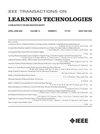使用聊天机器人促进在线自我调节学习和社交存在:基于证据的设计原则
IF 2.9
3区 教育学
Q2 COMPUTER SCIENCE, INTERDISCIPLINARY APPLICATIONS
引用次数: 0
摘要
在在线学习环境中,教学和评估都是虚拟的,学生主要负责管理自己的学习。这需要学生高度的自我调节能力。然而,许多在线学生缺乏自我调节能力,对自主学习准备不足,这可能会导致学生对在线活动感到脱节。此外,由于社交互动有限,学生在网络活动中容易感到孤立。为了解决这些挑战,本研究探讨了使用聊天机器人来促进学生的自我调节学习策略,并促进社会存在,以减轻他们的孤立感。采用两阶段混合方法设计,本研究评估了学生在聊天机器人支持的在线学习中的行为参与、感知的自我调节学习策略和社交存在。在第一阶段(第一阶段研究),39名学生参与了一个目标设定的聊天机器人活动,该活动采用了SMART框架和社会存在指标。这些发现为第二阶段(第二阶段研究)改进聊天机器人设计提供了基础,在第二阶段研究中,25名学生与修改后的聊天机器人进行了互动,重点是目标设定、寻求帮助、自我评估以及与讲师在场的社交互动。结果表明,两项研究中的学生都对聊天机器人有积极的在线学习体验。对学生和教师的后续访谈为改进聊天机器人的设计提供了宝贵的见解和建议,例如用于持续监控自我调节习惯和个性化社交互动的聊天机器人。根据这些证据,我们讨论了一套聊天机器人的设计原则,以支持学生在在线环境中的自我调节学习和社交存在。本文章由计算机程序翻译,如有差异,请以英文原文为准。
Facilitating Online Self-Regulated Learning and Social Presence Using Chatbots: Evidence-Based Design Principles
In an online learning environment, both instruction and assessments take place virtually where students are primarily responsible for managing their own learning. This requires a high level of self-regulation from students. Many online students, however, lack self-regulation skills and are ill-prepared for autonomous learning, which can cause students to feel disengaged from online activities. In addition, students tend to feel isolated during online activities due to limited social interaction. To address these challenges, this study explores the use of chatbots to facilitate students’ self-regulated learning strategies and promote social presence to alleviate their feelings of isolation. Using a two-phase mixed-methods design, this study evaluates students’ behavioral engagement, perceived self-regulated learning strategies, and social presence in chatbot-supported online learning. In the first phase (Stage I Study), 39 students engaged in a goal-setting chatbot activity that employed the SMART framework and social presence indicators. The findings served as the basis for improving the chatbot design in the second phase (Stage II Study), in which 25 students interacted with the revised chatbot, focusing on goal-setting, help-seeking, self-evaluation, and social interaction with instructor's presence. The results show that the students in both studies had positive online learning experiences with the chatbots. Follow-up interviews with students and instructors provide valuable insights and suggestions for refining the chatbot design, such as chatbots for ongoing monitoring of self-regulation habits and personalized social interaction. Drawing from the evidence, we discuss a set of chatbot design principles that support students’ self-regulated learning and social presence in online settings.
求助全文
通过发布文献求助,成功后即可免费获取论文全文。
去求助
来源期刊

IEEE Transactions on Learning Technologies
COMPUTER SCIENCE, INTERDISCIPLINARY APPLICATIONS-
CiteScore
7.50
自引率
5.40%
发文量
82
审稿时长
>12 weeks
期刊介绍:
The IEEE Transactions on Learning Technologies covers all advances in learning technologies and their applications, including but not limited to the following topics: innovative online learning systems; intelligent tutors; educational games; simulation systems for education and training; collaborative learning tools; learning with mobile devices; wearable devices and interfaces for learning; personalized and adaptive learning systems; tools for formative and summative assessment; tools for learning analytics and educational data mining; ontologies for learning systems; standards and web services that support learning; authoring tools for learning materials; computer support for peer tutoring; learning via computer-mediated inquiry, field, and lab work; social learning techniques; social networks and infrastructures for learning and knowledge sharing; and creation and management of learning objects.
 求助内容:
求助内容: 应助结果提醒方式:
应助结果提醒方式:


